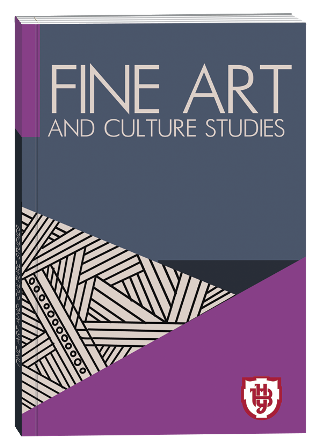PECULIARITIES OF CHINESE TRADITIONAL MUSIC
DOI:
https://doi.org/10.32782/facs-2024-5-12Keywords:
Chinese traditional music, musical form, rhythmic features, two-beat rhythm, principle of natural dualityAbstract
The relevance of this problem is due to the fact that the works of modern Chinese composers use structures that have a certain commonality with the considered forms, which helps to understand them better. By comparison with Western European musical forms, their characteristic differences and specific features are revealed. The purpose of the article is to consider the peculiarities of Chinese traditional music in view of formation of the most common varieties of its musical forms and the specifics of the rhythm. The following methods are used in the work: analytical – for the analysis of the approaches formed in art history literature in the direction of researching the phenomenon of Chinese traditional music; historical – to understand the historical aspects of the formation of Chinese traditional music. The scientific novelty. For the first time, the specifics of Chinese traditional music have been summarized on the basis of the application of the peculiarities of musical form and rhythm. In particular, the most common one-part, two-part, three-part forms, as well as variational, cyclical, and free forms are highlighted in Chinese traditional music. In the process of research, the following results were obtained and the following conclusions were drawn. The publication reveals the influence of Chinese poetic art on the formation of one or another musical form, which determines the commonality of principles in the structure of poetic and musical texts. It is emphasized that by analogy with Chinese poetry in one-part form, four stages of development can be distinguished – qi, chen, zhuang, he. The main varieties of the Chinese three-part form are characterized, including non-reprise (ABC) and reprise (ABA). Its differences from similar forms in Western European music are that the hierarchical subordination of themes is hardly noticeable; there is no pronounced contrast of thematics, which is a consequence of the tendency to gradually reveal the image; there is a complete structure of each section of the form; the function of the semantic center is performed by the middle section, not the first, as in European music. Among the varieties of the Chinese variation form, jiahua, free variations and banshi are defined, the formation of which was determined by the influence of national genres. It is emphasized that the cycle form (ABACAD) in Chinese traditional music is close to the rondo in Western European music. The repeated section A implements a connecting function, and the main content load is located in sections B, C, D, etc., for this reason, the completion of the form can take place on one of the contrasting themes. It is noted that the cyclical form (or qipailianchui ti), which originated in the bowels of the Chinese theater siqiu, consists of several sections, and those, in turn, consist of a number of chants (or qipai). The specificity of free form is manifested in the peculiarities of various forms characteristic of Chinese traditional music. The peculiarities of the rhythm are characterized, which consist in the fact that, with the exception of special cases (for example, introductions in a free rhythm), the majority of Chinese music is written in a two-beat rhythm. This preference for the two-beat rhythm (the Western equivalent of 2/4 and 4/4) is based on the principle of natural duality (e.g., the relationship between feminine and masculine or yin-yang). The conclusions summarize the differences in the principles of the development of Chinese and European music, in particular, the role of the gradual deployment of musical material inherent in Chinese music is determined; and they also describe the role of contrast, juxtaposition of musical information in European music. The peculiarities of the rhythm are summarized, which consist in the predominance of two-beats, as well as variability, which involves even and odd changes of complex elements of musical dimensions.
References
Han Mei (2000). Historical and Contemporary Development of the Chinese Zhen (A Thesis of the Degree of Master of Arts. Vancouver). The University of British Columbia.
Kao Shu Hui Daphne (2003). The Development of the Modern Zheng in Taiwan and Singapore (PhD theses). Durham University. URL: http://etheses.dur.ac.uk/11860/
Mei Xiao, Yung Bell, Wong Anita (2019). The Musical Arts of Ancient China. URL: https://hub.hku.hk/bitstream/10722/54787/2/31800700.pdf.
Алжнєв Ю., Осадча В. Звукообраз традиційного музикування в сучасному народноінструментальному виконавстві. Культура України. 2015. Вип. 51. С. 14–25.
Ван Яньсуй. Музичне мистецтво у призмі давньокитайської філософської думки. Fine Art and Culture Studies. 2022. Вип. 1. С. 19–27. URL: http://journals.vnu.volyn.ua/index.php/art/article/view/475/431
Ван Яньсуй. Естетичні засади пейзажності у китайському музичному мистецтві. Fine Art and Culture Studies. 2023. Вип. 3. С. 26–32. URL: http://journals.vnu.volyn.ua/index.php/art/article/view/1211/1124
Ван Яньсуй. Звукообраз як категорія музичного мистецтва. Proceedings of the 5th International Scientific Conference «Scientific Results». Rome, 2023. РР. 174–177. URL: https://ojs.publisher.agency/index.php/SR/issue/view/63/166.
Лі Чень. Традиційний китайський інструмент гучжен у фокусі наукової думки. Слобожанські мистецькі студії. 2024. № 2 (05). С. 50–53.
Лю Бінцян. Методологічні аспекти проблеми історико-типологічної синхронії музичного мистецтва Китаю та Європи. Мистецтвознавчі записки. 2015. Вип. 27. С. 13–22. URL: http://nbuv.gov.ua/UJRN/Mz_2015_27_4.
Ма Вей. Концепція форми в музиці Китаю і Європи: аспекти композиції та виконавства : автореф. дис. канд. мист.: 17.00.03. Одеса : Одеська національна музична академія імені А. В. Нежданової, 2004
Москаленко В. Лекції з музичної інтерпретації: навчальний посібник. Київ. 2013. URL: https://knmau.com.ua/wp-content/uploads/V.-Moskalenko-Lektsiyi-z-muzichnoyi-interpretatsiyi-Navchalnijposibnik.pdf
Ульянова В. Особливості музичного мистецтва Китаю. Актуальнi питання гуманiтарних наук. 2024. Вип. 71, том 3. С. 273–278. URL: http://www.aphn-journal.in.ua/archive/71_2024/part_3/46.pdf
Устименко-Косоріч О. А. Традиційне та європейське в контексті розвитку виконавства на духових інструментах (на прикладі флейтової китайської школи). Слобожанські мистецькі студії. 2024. № 2. С. 101–104. URL: https://journals.spu.sumy.ua/index.php/art/issue/view/24/24







